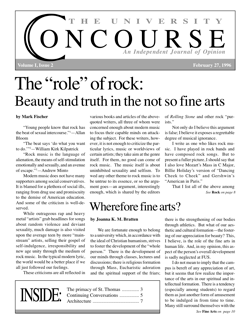The Aesthetics of Architecture
by Mary McElwee
In seeking respite from the practical concerns of everyday life in modern America, we often turn to beautiful music or good literature; we may go for a brief drive in the country, realizing perhaps unconsciously that beauty refreshes the soul. Reflection on our normal surroundings, however, causes us to realize that much of what surrounds us today is frighteningly lacking in beauty—more now, in fact, than in any previous age.
Probably the most obvious of these defects in aesthetic quality manifests itself in modern architecture. Although we may not realize how much we are affected by it, I think few would disagree that something vital has been lost since the days when, in spite of its essentially practical nature, architecture (along with the other arts) was a way for man to exercise his participation in the Divine Nature, through the creation of beautiful things. Today we live with the legacy of a cultural period devoted to utilitarian concerns, which reduced architecture to its purely practical functions. The unfortunate result of this movement is all too plainly exemplified in the omnipresent hulking blocks of concrete, almost unworthy of being called “architecture,” to which we in America have become accustomed.
The main argument offered on behalf of modern architecture is (not surprisingly) a utilitarian one. Modernists argue that a church, for example, built in modern style serves the same purpose as one built in the Gothic or Baroque style, in addition to being built more simply and cheaply, from easily obtainable materials and according to modern safety standards. And certainly it is in some ways true that the two serve the same purpose. But architecture should not be exclusively about function; it should also take into account meaning and beauty. The architects of old seemed to have a much better sense of this; their churches “functioned” perfectly, and at the same time pleased the senses and reflected the structures of the Faith. For example, the oldest churches are built on what is called the “Latin cross plan:” the sanctuary forms the head of the cross, the long center aisle the foot, and the cross-section which until recently held the communion rail formed the two arms. In addition, the oldest churches were built in such a way that the altar always faced east, the direction from which was anticipated the second coming of the Son of God.
Churches are not the only instances of architecture in which the appearance of a building should conform to high aesthetic standards; anything which man builds should give credit not only to his rational nature but also to his aesthetic sensibility. Today we see not only ugly churches, but ugly apartment buildings and stores, places of business and social interaction. Many times these are disturbingly reminiscent of the bleak, monstrous constructions of the communist governments in Eastern Europe.
If such things were to be found only in the poorest of communities, we might find economic excuse for their appearance, but architecture designed strictly for utilitarian purposes without regard to beauty has become the norm for modern society at every level.
Here at the University, we are in the unfortunate predicament of having been left with many buildings which were built in just the utilitarian period of which I previously spoke. Attempts at simplicity, not only in the structures of the dormitories but also of the J. C. Williams Center, the classroom buildings, and the chapel, resulted in simplicity only insofar as these buildings are sadly lacking in style and beauty. Our task, however, is not to criticize the mistakes of a previous age, especially when nothing can be done now to remedy those mistakes. Rather, we must try to ensure that the same mistakes are not made again; we must do all we can to promote architecture that will give glory to God by manifesting the abilities of man to attain to beauty.
Already there is cause for hope in the fact that newer buildings are great improvements over the old—note, for instance, the John Paul II Library and the Finnegan Fieldhouse; and certainly the Portiuncula chapel is one of the most charming aspects of the campus. Also, good landscaping has made our surroundings much more pleasant.
These improvements are a good sign, despite the unfortuate fact that the more pleasing developments in modern architecture are clearly originating in secular society rather than in the efforts of any religious organizations. We see skyscrapers which, while perhaps unpleasant in other respects, at least are not ugly. Shopping centers with a quaint, pleasant appearance arise amid seas of concrete. Yet the construction of churches, those buildings which should be the most beautiful, lags far behind.
One question we moderns need to ask ourselves is this: Does beauty really cost so much?
Perhaps the answer lies in the past. After all, for thousands of years up until the last century, men were building structures which not only served man’s needs but also pleased the eye, while they refreshed the soul. As members of the Church and people who can see and appreciate things not of this world, it is our task not only to bring God to our fellow-men but also to raise ourselves and others to higher levels of awareness and spirituality. Should we not therefore do all that we can to bring to the world all that is good, including beauty?
Mary McElwee is a senior majoring in Classics


